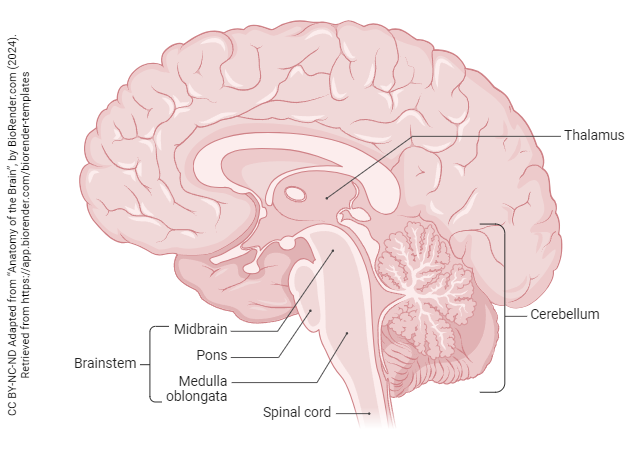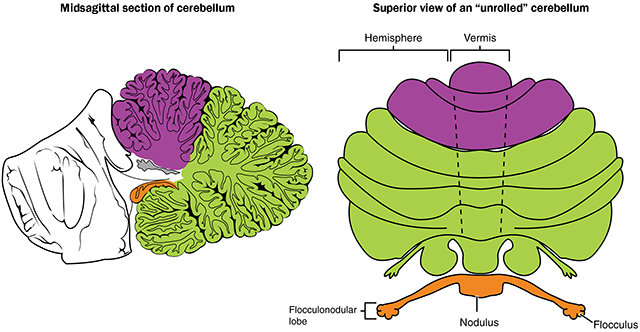The Pons and Cerebellum
Jim Hutchins
Objective 7: Recognize important structures of the pons and cerebellum.
Important Locations Objective 7 Video Lecture
The pons (Latin: “bridge”) consists of a massive band of fibers sweeping from one side of the brainstem to the other. This means it forms a characteristic bulge on the ventral (anterior) side of the brainstem and it’s easy to spot. What are all those fibers doing? They are carrying information from one side of the cerebellum to the other. You can think of the cerebellum as a sort-of annex of the brainstem.

Upper Motor Neurons: Cerebellar Circuits
 Just as the pathway from primary motor cortex to spinal cord is called the pyramidal motor system, the motor systems which don’t travel this pathway are called extrapyramidal motor systems. The two main extrapyramidal motor systems, which we’ll discuss now, are the cerebellar circuits and the basal nuclei circuits.
Just as the pathway from primary motor cortex to spinal cord is called the pyramidal motor system, the motor systems which don’t travel this pathway are called extrapyramidal motor systems. The two main extrapyramidal motor systems, which we’ll discuss now, are the cerebellar circuits and the basal nuclei circuits.
As with all circuits we’ll study in this unit, there are multiple interconnections between processing centers (nuclei) in the central nervous system. The cerebellum receives input (cerebellar afferents) from a number of motor nuclei, including the red nucleus in the midbrain and the motor nuclei of the thalamus (ventral anterior and ventral lateral), from the pons, and from the vestibular nuclei of cranial nerve VIII in the medulla.
In return, the cerebellum sends its output (cerebellar efferent) first to the cerebellar nuclei, and then to the inferior olive of the medulla and vestibular nuclei.
Put simply, the job of the cerebellum is to compare what is actually happening (the body position in space; the touch system) to the intended motor program developed by primary motor cortex, and make corrections as needed.
Media Attributions
- Anatomy of the Brain © BioRender adapted by Jim Hutchins is licensed under a CC BY-NC-ND (Attribution NonCommercial NoDerivatives) license
- Cerebellar regions © Betts, J. Gordon; Young, Kelly A.; Wise, James A.; Johnson, Eddie; Poe, Brandon; Kruse, Dean H. Korol, Oksana; Johnson, Jody E.; Womble, Mark & DeSaix, Peter is licensed under a CC BY (Attribution) license

